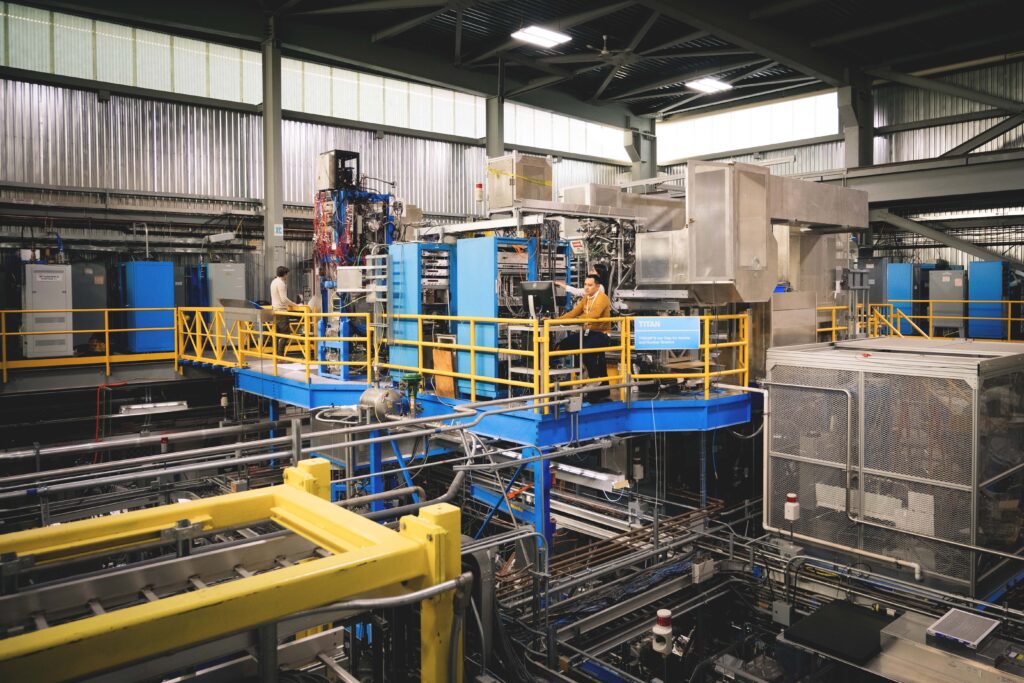The CERN-based MIRACLS experiment published a new paper today detailing a novel technique for measuring electron affinity, a key atomic property that shapes how chemical bonds form. The work builds on years of shared expertise and community connections between TRIUMF and the Geneva-based world’s largest particle physics laboratory.
The paper introduces a new, highly sensitive method for probing how tightly neutral atoms can hold onto an additional electron to form a negative ion, combining two powerful experimental tools: collinear laser spectroscopy (CLS) and ion trapping in multi-reflection time-of-flight (MR-TOF) devices.
By revealing how strongly atoms attract an additional electron, electron affinities offer vital clues to how chemical bonds form — yet for the heaviest elements on the periodic table, this property is still largely a mystery and unknown. The increased sensitivity of the MIRACLS-enabled technique could thus provide new insights into “superheavy” elements, nuclei so massive and unstable that they do not exist in ordinary matter but can be synthesized at specialized particle-accelerator laboratories. It could also support the study of certain naturally occurring elements of interest, such as actinium, which are found on Earth only in trace amounts yet hold promise for medical applications.

Deeper looks using lasers
With CLS, a beam of ionized atoms (like those produced at TRIUMF or CERN’s ISOLDE facility) is accelerated down a narrow vacuum tube, all moving in the same direction at high speed. A laser beam travels alongside, perfectly aligned.
During electron affinity measurements, the laser photons strike negative ions and can dislodge the extra electron — but only if the photons have enough energy to break the atom’s grip. By adjusting the laser’s wavelength, scientists are able find the precise energy above which the negative ion releases its additional electron, revealing the atom’s electron affinity.
Across the periodic table, electron affinities span a broad range – from close to zero in noble gases to their peak values in halogens. This contrast mirrors their chemistry: halogens readily attract electrons and form strong chemical bonds, whereas noble gases remain mostly inert. Collinear laser spectroscopy lets researchers detect these differences with very high precision and map how tightly each element holds onto an electron, revealing the energy architecture of the periodic table.
Mirror, mirror
What about elements that live only seconds or minutes, or those that can be produced just a few atoms at a time — such as superheavy elements at the far edge of stability? For these, a brief encounter with the laser produces too weak a signal. To overcome this, MIRACLS used a clever twist on a technique called multi-reflection time-of-flight (MR-ToF) ion trapping.
MR-ToF traps oscillate ions between two electrostatic ion mirrors, bouncing them thousands of times like an ultra-narrow game of Pong, holding the ephemeral, often short-lived ions in place long enough to measure hard-to-capture properties, like their mass.
MIRACLS expanded the MR-ToF trapping approach to measure electron affinity instead. By folding many kilometers of flight path into mere tens of centimeters and adding a collinear laser beam, the team created an artificially long ‘beamline’, massively increasing the ion-laser interaction time that helps determine electron affinity. The technique was developed by MIRACLS Group Leader Stephan Malbrunot-Ettenauer (TRIUMF Research Scientist and Adjunct Professor at the University of Toronto) and paper’s second lead author Erich Leistenschneider (former TRIUMF graduate student) who builds on his experience wielding the MR-TOF that is currently operating at the heart of TRIUMF’s TITAN facility.

In the MIRACLS result, the CLS-MRTOF method was tested on stable chlorine, an element with a well-studied electron affinity. “Despite using a hundred thousand times fewer chlorine anions, our novel MIRACLS method measures the electron affinity with precision matching that of conventional techniques, in which anions pass through the laser beam only once compared to about sixty thousand times in our experiment,” says lead author of the study Franziska Maier, for part of this work TRIUMF postdoctoral researcher stationed at CERN. “Our approach essentially uses the trap’s ion mirrors to ‘recycle’ the negative ions, opening a path towards electron affinity measurements of very scare samples.”
These results demonstrate the MIRACLS technique’s sensitivity and thus its potential for exotic, short-lived species at the edges of stability. After the successful demonstrator experiment at CERN, the MIRACLS device is now shipped to Lawrence Berkeley National Laboratory (LBNL), where it will be used to investigate superheavy elements, validate theoretical chemistry, and support the study and development of medical isotopes like actinium.
Erich Leistenschneider added that the properties of superheavy elements could blur the boundaries of the periodic table. “As the number of protons increases, Einstein’s relativity scrambles the structure of the atoms. For this reason, one may speculate whether the boundaries between element groups in the periodic table could fade, and the chemistry of superheavy elements may deviate from the ‘normal’ periodic trends. The electron affinity is one of the properties that will be largely affected by those effects, and our measurements will probe them.”
The results from this NSERC-supported experiment also highlight the invaluable international bonds that connect Canada to CERN and the wider international physics community.
“MR-ToF instruments, like the one so successfully used at TITAN@TRIUMF, are now indispensable for pushing the frontiers of research on exotic rare isotopes all across the globe,” explained Stephan Malbrunot-Ettenauer. “Thanks to our MIRACLS approach, we now extend their use to a wider range of experiments, including laser spectroscopy.” This achievement underscores how TRIUMF-built expertise sparks innovation and allows leadership in international collaborations, as the one at CERN in the present case. The timing could hardly be better: new experimental capabilities such as MIRACLS will both enhance and draw strength from TRIUMF’s upcoming ARIEL facility, which is set to drive breakthroughs in fundamental science and practical applications.
You can read more about the publication here.
Congratulations to the MIRACLS team!



